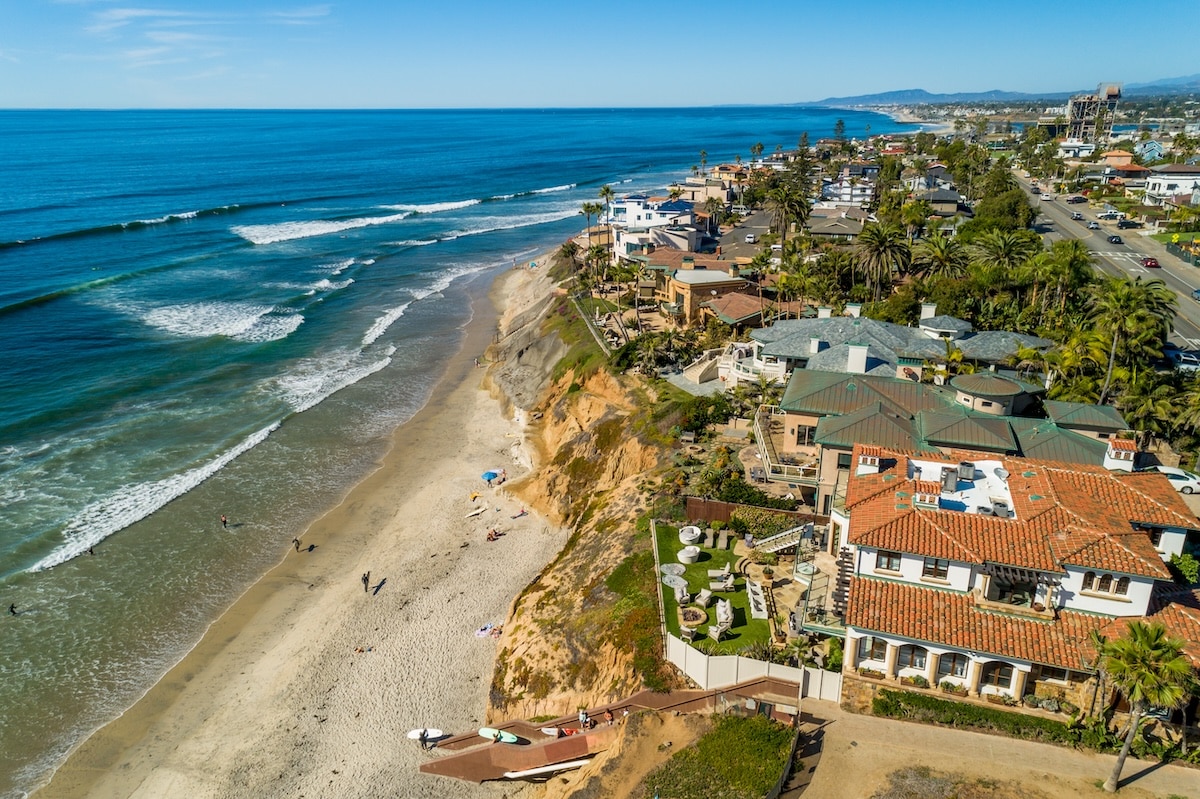
Introduction
Welcome to the vibrant and dynamic real estate landscape of Coastal North County San Diego, where opportunities abound for savvy investors looking to make their mark in one of California’s most sought-after markets. As an experienced real estate agent deeply rooted in this region, I understand the intricacies and nuances that define successful investment strategies tailored specifically for San Diego. In this guide, I’ll provide you with valuable insights, market trends, neighborhood analyses, property types, financing options, and risk management techniques to help you navigate and thrive in our competitive market.
Understanding the San Diego Real Estate Market
San Diego’s real estate market has long been characterized by its resilience, steady appreciation, and diverse investment opportunities. Here’s a snapshot of the current market trends:
Steady Appreciation
One of the most compelling reasons to invest in San Diego real estate is its history of steady appreciation. Let’s delve deeper into what drives this consistent growth and how investors can leverage it to their advantage:
-
-
- Economic Resilience: San Diego boasts a diverse and robust economy, anchored by thriving sectors such as biotechnology, defense, tourism, and higher education. This economic diversity helps insulate the real estate market from downturns and contributes to its long-term stability and growth.
- Desirable Lifestyle: Known for its idyllic climate, stunning beaches, outdoor recreational opportunities, and vibrant cultural scene, San Diego consistently ranks among the top places to live in the United States. The city’s quality of life attracts a steady influx of residents and visitors alike, driving demand for housing and supporting property values.
- Limited Supply: Despite strong demand, San Diego faces constraints on housing supply due to factors such as geographic boundaries, stringent land use regulations, and limited developable land. This imbalance between supply and demand exerts upward pressure on home prices, contributing to the market’s steady appreciation over time. We’ll dig into that more later in the article.
- Investment in Infrastructure: San Diego continues to invest in infrastructure projects aimed at improving transportation, enhancing public amenities, and fostering economic development. These investments not only enhance the overall quality of life but also contribute to the attractiveness of real estate investments in the region.
- Historical Performance: Over the past several decades, San Diego has demonstrated a track record of consistent and resilient real estate appreciation, even during periods of economic uncertainty. Investors can take confidence in this historical performance as they assess the long-term viability of their investment strategies.
-
High Demand
One of the driving forces behind San Diego’s real estate market is its consistently high demand. Let’s explore the factors contributing to this demand and how investors can capitalize on it:
-
-
- Desirable Location: Situated along the stunning coastline of Southern California, San Diego offers residents an enviable lifestyle characterized by year-round sunshine, picturesque beaches, and a plethora of outdoor recreational opportunities. The city’s desirable location attracts a diverse array of residents, from young professionals to families and retirees, all seeking to call San Diego home.
- Booming Tech Industry: San Diego is home to a thriving tech ecosystem, with companies ranging from established giants to innovative startups driving employment growth and economic prosperity. The presence of renowned research institutions, such as UC San Diego, further fuels the region’s tech sector, attracting top talent and fostering innovation. As a result, the demand for housing near tech hubs and employment centers remains strong, particularly among tech industry professionals.
- Quality Education: With top-ranked schools, prestigious universities, and renowned research institutions, San Diego offers families access to quality education at all levels. The availability of excellent educational opportunities is a significant draw for families with school-aged children, driving demand for homes in neighborhoods with highly regarded school districts.
- Cultural Attractions: San Diego’s vibrant cultural scene, encompassing world-class museums, theaters, galleries, and festivals, adds to the city’s allure and appeal. Residents and visitors alike are drawn to the rich tapestry of cultural attractions and events, contributing to the vibrant and dynamic fabric of San Diego’s communities.
-
Limited Inventory
One of the defining characteristics of the San Diego real estate market is its limited inventory. Let’s delve into the factors contributing to this phenomenon and how investors can navigate the challenges and capitalize on opportunities:
-
-
- Geographic Constraints: San Diego’s geography, with its expansive coastline, rugged terrain, and protected natural habitats, presents significant challenges for new development. Much of the available land is already developed or subject to strict zoning regulations, limiting the expansion of housing supply.
- Stringent Land Use Regulations: San Diego’s regulatory environment, including zoning laws, building codes, and environmental regulations, imposes additional hurdles for developers seeking to bring new housing units to market. Permitting processes can be lengthy and complex, further delaying the delivery of new inventory.
- High Development Costs: The cost of land acquisition, construction materials, labor, and regulatory compliance adds to the expense of new development projects in San Diego. As a result, developers may prioritize high-end luxury projects or multi-family developments over more affordable housing options, exacerbating the shortage of entry-level and workforce housing.
- Historical Preservation: San Diego boasts a rich architectural heritage, with many neighborhoods featuring historic buildings and structures. While historical preservation adds to the city’s charm and character, it also limits opportunities for new development in designated historic districts or areas with strict preservation ordinances.
- Rising Demand: Despite limited inventory, demand for housing in San Diego remains robust, fueled by population growth, job creation, and lifestyle preferences. This imbalance between supply and demand puts upward pressure on home prices and rental rates, making affordability a growing concern for residents and investors alike.
-
Exploring the Diverse Neighborhoods of San Diego:
San Diego is renowned for its diverse array of neighborhoods, each offering its unique character, amenities, and investment potential. Let’s take a closer look at some of the standout neighborhoods in Coastal North County San Diego:
- Cardiff by the Sea: Nestled along the picturesque coastline, Cardiff by the Sea exudes coastal charm and laid-back sophistication. This tight-knit community offers residents access to world-class beaches, scenic parks, boutique shops, and top-rated restaurants. With a mix of single-family homes, oceanfront estates, and luxury condominiums, Cardiff by the Sea attracts discerning buyers seeking a quintessential coastal lifestyle.
- Del Mar: Known for its upscale ambiance, Del Mar is synonymous with luxury living and prestigious equestrian events. Home to the iconic Del Mar Racetrack and Fairgrounds, this affluent enclave boasts multimillion-dollar estates, gated communities, and exclusive beachfront properties. Investors drawn to Del Mar can capitalize on its prime location, upscale amenities, and strong demand from affluent buyers.
- Encinitas: With its eclectic blend of surf culture, vibrant arts scene, and family-friendly neighborhoods, Encinitas offers something for everyone. From the funky vibe of Leucadia to the upscale elegance of Olivenhain, each neighborhood within Encinitas has its unique appeal. Investors can explore a range of property types, including beachfront cottages, hilltop estates, and modern townhomes, catering to diverse lifestyle preferences and investment objectives.
- Carlsbad: Boasting a thriving economy, award-winning schools, and picturesque coastal scenery, Carlsbad is a magnet for families, professionals, and retirees alike. The city’s diverse neighborhoods, such as La Costa, Aviara, and Bressi Ranch, offer a mix of housing options, including golf course communities, master-planned developments, and luxury estates. Investors can tap into Carlsbad’s strong rental market and steady appreciation potential while enjoying the area’s recreational amenities and quality of life.
- Solana Beach: Tucked between Del Mar and Encinitas, Solana Beach is a hidden gem known for its relaxed vibe, charming downtown district, and stunning coastal bluffs. This quaint seaside community attracts residents seeking a laid-back lifestyle, with easy access to beaches, parks, boutiques, and dining establishments. Investors can capitalize on Solana Beach’s tight-knit community atmosphere and limited housing supply by targeting well-maintained properties in desirable neighborhoods.
Crafting Effective Real Estate Investment Strategies
Now, let’s delve into the key components of crafting effective investment strategies tailored for the San Diego market.

Conducting In-Depth Neighborhood Analysis:
A crucial aspect of mastering real estate investment strategies in San Diego is conducting thorough neighborhood analysis. Let’s explore the key factors to consider when evaluating potential investment opportunities:
- Location and Accessibility: Assess the neighborhood’s proximity to major employment centers, transportation hubs, schools, shopping centers, and recreational amenities. Properties located in convenient, well-connected neighborhoods tend to command higher demand and appreciation potential.
- School Districts and Educational Institutions: Research the quality of local school districts and educational institutions, as this can significantly impact property values and appeal to families with school-aged children. High-performing schools often correlate with higher home prices and rental rates.
- Market Trends and Appreciation Potential: Analyze historical sales data, market trends, and appreciation rates to gauge the long-term growth potential of the neighborhood. Look for areas experiencing consistent appreciation and strong demand, indicating a healthy and stable real estate market.
- Property Types and Housing Inventory: Evaluate the mix of property types available in the neighborhood, including single-family homes, condominiums, townhouses, and multi-family units. Understand the supply-demand dynamics and absorption rates for different property types to identify investment opportunities that align with your investment goals and target market.
- Community Amenities and Lifestyle: Consider the availability of community amenities such as parks, recreational facilities, dining establishments, cultural attractions, and entertainment options. Neighborhoods with vibrant amenities and a desirable lifestyle appeal to a broad range of residents and tenants, driving demand and supporting property values.
- Future Development and Infrastructure Projects: Stay informed about planned development projects, infrastructure improvements, and revitalization efforts in the neighborhood. These initiatives can enhance property values, attract new residents and businesses, and contribute to the overall growth and desirability of the area.
Exploring Property Types in San Diego
San Diego offers a diverse range of property types, each presenting unique opportunities and considerations for real estate investors. Let’s explore the various property types available in Coastal North County San Diego:
- Single-Family Homes:
-
- Single-family homes are the most common property type in San Diego, ranging from cozy bungalows to expansive estates.
- These homes appeal to a broad range of buyers and tenants, including families, professionals, and retirees.
- Investors can capitalize on the stability and appreciation potential of single-family homes, particularly in desirable neighborhoods with strong demand and limited inventory.
-
- Condominiums and Townhouses:
-
- Condominiums and townhouses offer a low-maintenance lifestyle and amenities such as swimming pools, fitness centers, and gated security.
- These properties are popular among first-time homebuyers, young professionals, and empty nesters seeking urban convenience and community amenities.
- Investors can benefit from the affordability and rental income potential of condominiums and townhouses, particularly in urban and coastal areas where space is limited.
-
- Multi-Family Units:
-
- Multi-family units, including duplexes, triplexes, and apartment buildings, provide investors with opportunities to generate consistent rental income and build long-term wealth.
- These properties are well-suited for investors seeking to diversify their portfolios and leverage economies of scale through bulk acquisitions.
- With careful management and maintenance, multi-family units can offer attractive cash flow and appreciation potential, particularly in high-demand rental markets.
-
- Luxury Estates:
-
- Luxury estates and waterfront properties cater to affluent buyers seeking exclusivity, privacy, and luxury amenities.
- These properties command premium prices and offer unparalleled views, architectural craftsmanship, and lifestyle amenities such as private beaches, infinity pools, and wine cellars.
- Investors with a high net worth may consider luxury estates as part of a diversified investment portfolio, balancing appreciation potential with lifestyle preferences and prestige.
-
- Mixed-Use Developments:
-
- Mixed-use developments combine residential, commercial, and retail components in a single property, offering residents convenience and access to amenities.
- These developments are well-suited for urban infill projects and transit-oriented developments, catering to the growing demand for walkable, live-work-play environments.
- Investors can capitalize on the synergies between residential and commercial uses, diversify income streams, and create vibrant, sustainable communities that enhance property values and appeal to a diverse range of residents.
-
Exploring Financing Options for Real Estate Investments
Securing the right financing is crucial for real estate investors looking to capitalize on opportunities in the San Diego market. Let’s explore the various financing options available:
- Conventional Mortgages:
-
- Conventional mortgages are loans offered by banks, credit unions, and mortgage lenders that conform to the guidelines set by Fannie Mae and Freddie Mac.
- These loans typically require a down payment of 20% or more, although some lenders offer options with lower down payments for qualified buyers.
- Conventional mortgages offer competitive interest rates and terms, making them a popular choice for investors seeking long-term financing for rental properties and owner-occupied homes.
-
- FHA Loans:
-
- FHA loans are government-backed loans insured by the Federal Housing Administration, designed to help first-time homebuyers and low-to-moderate-income borrowers qualify for financing.
- These loans require a lower down payment of 3.5% and have more flexible credit requirements compared to conventional mortgages.
- FHA loans are well-suited for investors purchasing primary residences or investment properties with multiple units, such as duplexes or triplexes.
-
- VA Loans:
-
- VA loans are mortgage loans guaranteed by the U.S. Department of Veterans Affairs, available to eligible active-duty service members, veterans, and surviving spouses.
- These loans offer 100% financing with no down payment required and competitive interest rates, making them an attractive option for military personnel and veterans looking to purchase homes in San Diego.
- VA loans can be used to finance primary residences, investment properties, and multi-family units, providing flexibility and affordability for eligible borrowers.
-
- Private Lenders:
-
- Private lenders, also known as hard money lenders or private investors, offer short-term loans secured by real estate assets.
- These loans typically have higher interest rates and fees compared to traditional mortgages but offer faster approval and funding timelines.
- Private lenders are a popular option for real estate investors seeking bridge financing, fix-and-flip loans, or funding for investment properties that may not qualify for traditional financing due to property condition or credit history.
-
- Portfolio Loans:
-
- Portfolio loans are customized financing solutions offered by banks and credit unions that cater to the unique needs of real estate investors.
- These loans may offer more flexible terms, higher loan-to-value ratios, and creative financing structures tailored to individual investment strategies.
- Portfolio loans are ideal for investors with diverse real estate portfolios, complex financial situations, or unconventional properties that may not fit traditional lending criteria.
-
Implementing Effective Risk Management Techniques:
Real estate investment inherently involves risks, but proactive risk management strategies can help investors mitigate potential pitfalls and safeguard their investments. Let’s explore some essential risk management techniques for real estate investors in San Diego:
- Diversification:
-
- Diversification is a fundamental principle of risk management, spreading investment capital across multiple properties, neighborhoods, and asset classes.
- By diversifying your real estate portfolio, you can reduce exposure to individual property risks and market fluctuations, enhancing overall stability and resilience.
-
- Thorough Due Diligence:
-
- Conducting thorough due diligence is essential for evaluating investment opportunities and identifying potential risks.
- Perform comprehensive property inspections, financial analysis, and market research to assess the condition of the property, its income potential, and the prevailing market conditions.
- Verify zoning regulations, title issues, environmental concerns, and potential liabilities to mitigate legal and regulatory risks.
-
- Conservative Financing:
-
- Adopting conservative financing strategies can help investors manage leverage and reduce exposure to financial risks.
- Avoid overleveraging by maintaining adequate equity reserves and choosing financing options with favorable terms, such as fixed-rate mortgages and reasonable debt-to-equity ratios.
- Consider the potential impact of rising interest rates, vacancy rates, and market downturns when structuring financing arrangements.
-
- Maintain Cash Reserves:
-
- Building and maintaining cash reserves is essential for weathering unexpected expenses, market fluctuations, and economic downturns.
- Establish a contingency fund to cover property maintenance, repairs, vacancies, and other unforeseen expenses without compromising your investment objectives or financial stability.
-
- Stay Informed About Market Trends:
-
- Stay abreast of market trends, economic indicators, and regulatory changes that may affect real estate values and investment performance.
- Monitor local market conditions, supply-demand dynamics, rental trends, and demographic shifts to anticipate potential risks and opportunities.
- Engage with industry experts, attend networking events, and leverage market data and analytics to make informed investment decisions.
-
- Work with Experienced Professionals:
-
- Collaborating with experienced real estate professionals, including agents, brokers, attorneys, and property managers, can provide valuable insights and guidance throughout the investment process.
- Seek out professionals with local market expertise, industry knowledge, and a track record of success in navigating complex real estate transactions and mitigating risks.
-
Investing in Real Estate, Conclusion
In conclusion, mastering real estate investment strategies in San Diego requires a combination of market expertise, strategic planning, and proactive decision-making. By staying informed about market trends, conducting thorough research, and leveraging the guidance of experienced professionals, you can maximize your investment potential and achieve your financial goals in our dynamic market.
If you’re ready to explore real estate investment opportunities in Coastal North County San Diego, I invite you to contact me, Kelli Miller, to schedule a consultation. Together, we can tailor a customized investment strategy that aligns with your objectives and unlocks the vast potential of our thriving market.
Happy investing!

